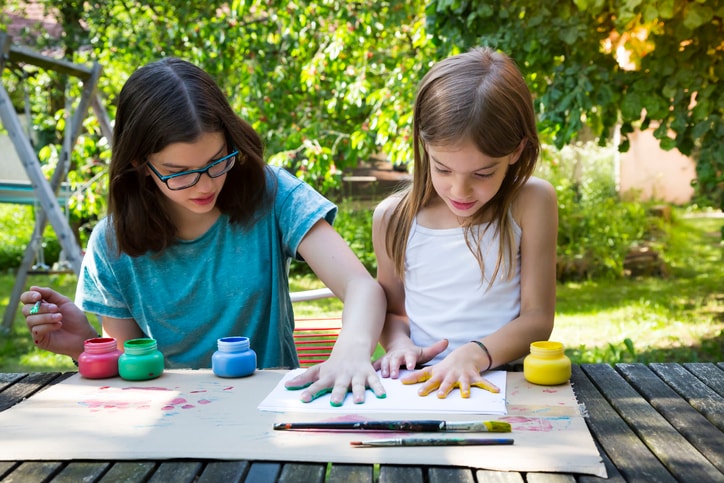Whether you’re looking to support your child with their social skills, communication skills or help them self-regulate, there are a number of engaging, enriching activities for autistic kids, which are incredibly helpful for their development. The keys, says Julie Mower, executive director of The Phoenix Center, a non-profit, private school for students with special needs in Nutley, New Jersey, are to determine what areas you’re looking to support — and to make it fun.
“Play is important for children on the autism spectrum because it can improve their social, communication and sensory skills,” she says, adding that “children on the autism spectrum may find social interactions challenging, in addition to sensory processing and motor planning, which can make it difficult for them to engage with others and learn from their environment.”
The right activities can “help children with autism develop these skills in a fun and engaging way,” Mower continues. “For example, playing games with other children can help them learn social skills, like taking turns and sharing. Playing with sensory-intensive toys can help improve their sensory processing abilities and help desensitize them to a variety of different textures. Engaging in imaginative play can help any child develop their communication and language skills, especially those on the autism spectrum.”
Looking for activities for kids with autism, but are at a loss of where to begin? Here, experts offer specific options, along with insight as to why they may be helpful.
Activities for autistic kids are not one-size-fits-all
While having an arsenal of activities in your back pocket is definitely helpful, keep in mind, what works well with one kid, doesn’t necessarily work with another. In order to find the right activities, it’s likely going to take some trial and error, says Alyssa Latham, a board-certified behavior analyst and parent coach at Ally ABA Consulting, which supports the development of neurodivergent kids.
“When it comes to knowing what activities will support your child’s needs, there is not a one-size-fits-all answer,” says Latham. “For instance, people often think of sensory bins filled with sand, rice or different textures. While these are a great option for some, there are many more ways to help children feel regulated through sensory play, such as being outside in the sunshine, playing with water or eating crunchy foods — and each day might be filled with a combination of all these things!”
In other words: You need to take your child into consideration, what their particular needs are that day (or moment) and test a few out to see which stick.
Sensory activities for autistic kids
“Many kids participate in sensory-related activities from a young age, but for children with autism, it can be especially beneficial,” says Jana Sarno, a board-certified behavior analyst and chief clinical officer at Hopebridge Autism Therapy Centers. “Not only do many sensory seekers enjoy these experiences, but those who struggle with sensitivities can join in to strengthen self-regulation and learn to cope with reactions to touch, sound, scent, sign, movement and taste.”
1. “Painting” with shaving cream
“One of my favorite simple sensory activities is window painting with shaving cream,” Sarno says. “Practice drawing pictures or just swirling it with fingers, then have them place their hands in it and press them to the window for different textures and temperatures. Have a towel ready for cleanup, which is also part of the fun.”
Other ways to “paint,” according to Martha Serfaty, an early intervention specialist in San Antonio, are with “ finger paints, pudding or slime.”
2. “Guess the smell”
“Families who like to bake may enjoy playing guess-the-smell games, which focus on a different sensory aspect,” suggests Sarno. “Use the ingredients you already have at home, such as peppermint extract, lemon, orange or cinnamon, to dab different scents onto a cotton ball for the child to smell. Ask them which scents they like or don’t like or to draw what they smell.”
3. Heavy work
“It is common for kids with autism to struggle with issues pertaining to sensory processing, attention and emotion regulation,” notes Sopanga Braje, a clinical psychologist in Palo Alto, California, who works with children on the autism spectrum. “Engaging children in ‘heavy work’ activities can help them regulate these executive functioning skills, as well as help them integrate sensory information.”
“Heavy work,” Braje explains, “is any activity that requires effort from our muscles. For instance, pushing, pulling or lifting an object are all heavy work. When kids with autism engage in this type of activity, they are receiving proprioceptive input — information about where our bodies exist in space.”
A few examples of heavy work that Braje suggests are:
- Tug-of-war.
- Pillow fights.
- Monkey bars.
- Manipulating clay.
“The natural environment can serve as a sensory playground, so use it to find different colored leaves, pine cones, flowers, tree bark, rocks and bugs.”
— JANA SARNO, A BOARD-CERTIFIED BEHAVIOR ANALYST
4. Treasure hunt
“If you have access to the outdoors, embark on a treasure hunt,” Sarno suggests. “The natural environment can serve as a sensory playground, so use it to find different colored leaves, pine cones, flowers, tree bark, rocks and bugs. Encourage kids to touch any safe, non-living items and talk about what makes each piece interesting.”
5. Sort snacks
“A snack sorting game combines two activities many of our kids enjoy — snacks and organizing,” says Sarno. “Give kids a plate of snacks that can be combined and encourage them to play. It can include some of their favorite treats plus some safe, new options to try. Crackers, raisins, M&Ms, freeze-dried strawberries, Cheerios, pretzel sticks and Earth’s Best Letter of the Day Cookies are all good options. Talk about the textures, colors and tastes as they sort and mix.”
Pro tip: “When you think of ‘sensory activities,’ the goal should be to regulate your child’s nervous system,” explains Latham. “If our nervous systems are heightened, they go ‘offline,’ which means the capacity to learn is unavailable. If our nervous systems are regulated, they are ‘online,’ and we are calm, relaxed, ready to engage with our environment and learn new things.”
Knowing your child’s dysregulation cues and when they’re going “offline” is crucial, Latham says. When you see this, “be their safe, calm person and help them move through the waves of their big emotions as they come back to a balanced state,” she says. “This is hard work for everyone and it takes a lot of practice, but it is very rewarding to see a child mature in their social-emotional skills while remaining their authentic self!”
Social skills activities and games
“Activities that support social competencies and communication skills throughout everyday routines are ideal for children with autism,” says Serfaty. “This type of skill development, which enables kids to interact successfully at home, at school and out in the community is crucial for their sense of belonging and development, and to enable them to reach their greatest potential.”
That said, Serfaty reminds parents to keep their child’s personal strengths and interests in mind when choosing these activities.
6. Get involved with solitary play
“As the tendency among those on the autism spectrum is to engage in solitary play, it’s important to get involved,” Serfaty says. “Encouraging a child to drive a toy car back and forth or to throw a ball with an adult or peer enables cooperative play and communication.”
Sarno agrees about parent and caregiver involvement across the board, “During all games and activities, I encourage incorporating language and communication, as well as modeling tasks and behaviors,” she says. “If adults join in — but also set aside time to sit back and let the kids enjoy on their own — it can be an opportunity for learning.”
7. Face them at the park
“On the playground, place the child on the swing and push them while facing them, rather than from behind,” Serfaty says. “Additionally, you can stand at the bottom of the slide as the child comes down, making exaggerated expressions of excitement. This increased eye contact promotes awareness of and appreciation for the person interacting with them.”
8. Grocery shop (with photos)
“A simple and routine chore, such as grocery shopping, can be more engaging when the pre-reading child is provided with a list of pictures of the items that need to be purchased,” notes Serfaty. “This supports communication skills, increased vocabulary development, attention to tasks, cooperative behaviors and more.”
9. Board games
There are a number of board games that can support social and communication skills for kids on the spectrum. “Kids with autism have limited theory of mind, which is the ability to understand what someone else may be thinking,” Braje says, noting that certain board games that require adopting the perspective of another person can be beneficial.
A few of her favorites are:
- Go Fish.
- Chess.
- Guess Who?
“These can engage those cognitive skills, as kids have to consider another person’s thinking process or perspective to play the game well,” she says.
Board games Mower and Sarno suggest are:
- Candyland.
- Chutes and Ladders.
- Sorry.
- The Bluey Scavenger Hunt Game.
“These help children with autism learn turn-taking, counting and other important social skills,” says Mower.
10. Role play
“Role-playing activities, like playing with dolls or action figures can help children with autism develop their communication and language skills by practicing social scenarios and conversations,” says Mower.
However, Braje notes, “People with autism struggle with imaginative play so it’s important to recognize and accept that kids with autism play in a different way than neurotypical kids. Adults should not try to redirect that play, but rather observe and participate with curiosity.”
Activities that help with fine and gross motor skills
In addition to structured activities, which have been proven to be incredibly beneficial to kids on the autism spectrum, general physical activities are important, too, says Mower. “Physical activities like swimming, dancing or playing catch can help children with autism improve their motor skills and coordination, while also providing a fun and engaging way to exercise.”
Sarno also likes this vegetable memory game, which “allows kids to practice planting and picking vegetables, which gets their fine motor skills in motion.”
“Parents don’t have to feel pressure to do anything other than participate in the pleasure of their child’s preferred play activity.”
— SOPANGA BRAJE, CLINICAL PSYCHOLOGIST
Activities for kids with autism: The bottom line
Finding activities to support a child with autism is great, but keep in mind, the process is nuanced and highly-personalized.
“The ‘right’ activities are highly dependent on the child and what their unique sensory, motor, communication, social/emotional processing and executive functioning capabilities are,” says Chloe Duckworth, the co-founder and CEO of Valence Vibrations, an emotion AI company that creates real-time emotional subtitles as a digital accessibility solution for neurodiverse teams.
“For tactile sensory seekers, some love trampolines and sensory toys like chewable jewelry. For those hypersensitive to sound, quieter activities like reading, building a puzzle, or even a whole computer might be better suited. Overall, the best activities to do with autistic kids are ones that lean into their special interests.”
“A nonspeaking child that loves reading about dinosaurs and learning everything about them would love to go to the museum,” she continues. “Autistic children struggle most when parents, caregivers and doctors try to force a round peg into a square hole, rather than supporting their unique communication style and interests.”
And as Braje concludes, the best types of play are the ones children choose themselves because they’re fun and enjoyable. She concludes, “The purpose of play is to increase positive emotions and facilitate social bonding. Viewed from this vantage point, parents don’t have to feel pressure to do anything other than participate in the pleasure of their child’s preferred play activity.”






